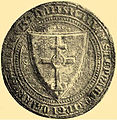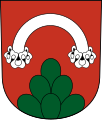Mount (heraldry)
In heraldry, a mount (also mountain, hill, hillock) is a representation of a hill or mountain as a curved terrace in base.[1] When the mount is included in the lower part of the shield, it may be considered an ordinary rather than a charge.
A trimount, also called a mount mounted, shapournet shapourned, or (in German) Dreiberg, is a representation of a mount with three tops.[2] The trimount can be found throughout heraldic traditions (Gallo-British, German-Nordic, and Latin), but it is especially common in Switzerland.[3]
A design of six hills (Sechsberg) can also be found in Swiss and Italian heraldry. For mounts with more than three tops, the number of tops is blazoned as coupeaux, e.g. German Sechsberg would be a mount of six coupeaux, and German Zehnberg as a mount of ten coupeaux.[3] A mount with more than six tops can also be blazoned as Schroffen in German heraldry. In medieval German heraldry, mounts could have more than ten peaks.[4]
Terrace in base curved
[edit]A terrace in base curved is blazoned mount, hill, or hillock when represented in vert; sometimes as a mount vert for clarity. A terrace in base curved may occasionally be blazoned as mount even when not tinctured vert; this is mostly found in cases where the base represents a hill for one or several of the charges in the coat of arms. Classification of a mount as either an ordinary or a charge, is, in many cases, a matter of interpretation.
-
Altafulla (Or, a mount gules surmounted by a leaf vert)
Double mount
[edit]Trimount
[edit]The coats of arms of Hungary and Slovakia depict a trimount with a double cross, first used in the seal of Stephen V of Hungary (r. 1270–1272). At first, it was only a small element at the bottom of the coat of arms, later it became a regular heraldic figure. Originally it represented biblical Golgotha.[5][6][7] Modern day Slovak interpretation is that it represents three mountain ranges of the Kingdom of Hungary: the Tatra, Fatra, and Mátra.[8][9][10]
-
Seal of Stephen V of Hungary (c. 1270), coat of arms of Hungary
-
Seal of Wenceslaus III of Bohemia (c. 1301), coat of arms of Slovakia
The representation of three pointed mountains (not a heraldic trimount) in the 1991 coat of arms of Slovenia symbolises Triglav, the highest mountain in Slovenia.
Mount of four coupeaux
[edit]-
Helfenstein (Zurich armorial)
Mount of five coupeaux
[edit]-
Freundsberg (Frontsperg, Frundsberg), 16th century
Mount of six coupeaux
[edit]-
Grünenberg (15th century)
-
Freundsberg (Fronsberg, Frundsberg)
Mount of ten coupeaux
[edit]-
Grünenberg (Zürich armorial)
Mount of twelve coupeaux
[edit]References
[edit]- ^ "Armorial Gold Heraldry Symbolism Library". Armorial Gold. Retrieved 30 June 2013.
- ^ "Mount" in: William Berry, Encyclopaedia Heraldica, Or Complete Dictionary of Heraldry (1828).
- ^ a b The Coat of Arms, Vol. 3, No. 17; Heraldry Society; 1966; pp. 36 ff. [full citation needed]
- ^ Seals of the Salenstein coat of arms show a mount of twelve tops in 1264, and even one with twenty-eight in 1297.
Herdi, Ernst (1943). "Die Schenken und die Dienstmannen von Salenstein". Thurgauische Beiträge zur vaterländischen Geschichte (in German). 79: 47 ff. - ^ "Štátny znak Slovenskej republiky".
- ^ "Byzantské korene štátneho znaku SR". 13 September 2019.
- ^ "Ako vznikal štátny znak. Pozrite si doteraz skryté socialistické návrhy".
- ^ "Úrad vlády Slovenskej republiky / Štátny znak".
- ^ Tecco, Betsy Dru (2005). How to Draw Hungary's Sights and Symbols. New York: Rosen Publishing Group. p. 18. ISBN 978-1-4042-2737-8.
- ^ Glevická, Marcela (10 February 2017). "Ako vznikal štátny znak: Pozrite si doteraz skryté socialistické návrhy". Sme. Bratislava.




























